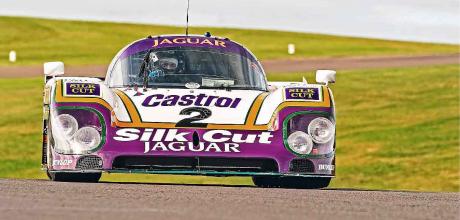1988 Jaguar XJR-9LM
The Silken Touch Thirty-five years after this very XJR-9 scored Jaguar’s first Le Mans win since the D-type days, we relive the memories – then drive it on track.
Words JAMES TAYLOR & SAM DAWSON
Photography JORDAN BUTTERS
On track in the Jaguar that scored the firm’s first Le Mans win since the days of the D-type – and made grown men cry
The Silken Touch
Driving the XJR-9 that scored Jaguar’s emotional 1988 Le Mans win
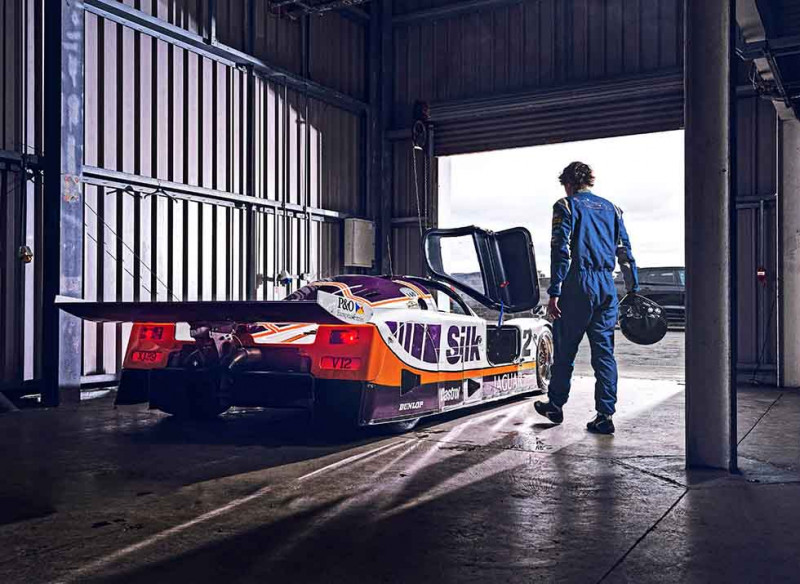
British motor sport fans aren’t the most emotional bunch. Not for us the red flare-waving antics of the Ferraristi or the beer-fuelled partisanship of NASCAR or Bathurst. But for 24 hours in June 1988, normal service was suspended. As a balmy late-spring day blazed over La Sarthe, grown men sobbed into bedsheets daubed with ‘GO FOR IT LADS’ hung over trackside advertising hoardings, as a lone Jaguar XJR-9 crossed the finish line in first place. As the tail-enders double-declutched their way onto the parade lap, the emotional pressure became too great. Like football fans celebrating a World Cup win, the British spectators swarmed onto the track. Today, I’m at Anglesey to drive the very car they leapt over the barriers to mob. The first Jaguar to win the Le Mans 24 Hours since 1957.
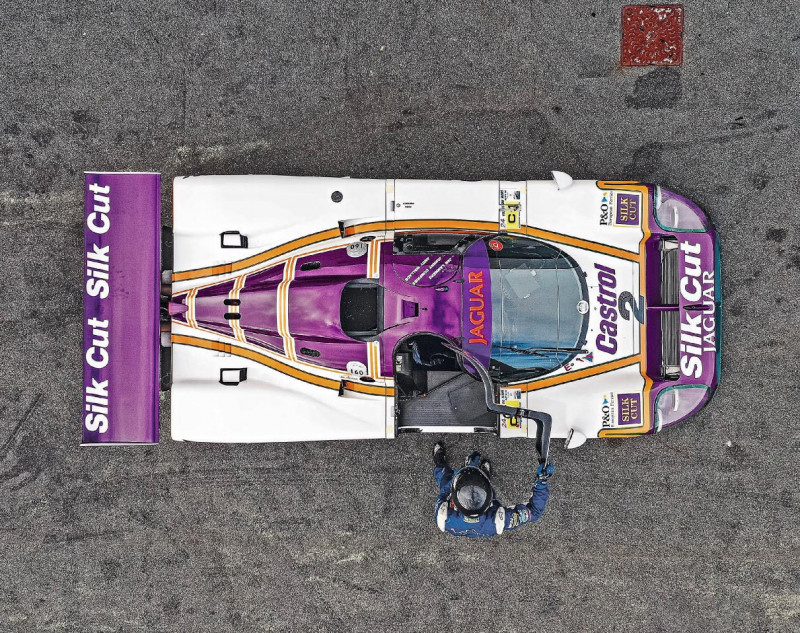
It's hard to recall just how emotionally powerful the Eighties’ Group C era felt. The formula that in 1982 replaced the labyrinthine old numbered Group system suited both garagistes and big manufacturers alike – the former could concentrate on what they did best without worrying about sources of funding, while the latter just needed to supply engine blocks and sponsorship deals to bankroll it all rather than build expensive homologation specials. But early on into Group C’s run, the high-tech Porsche 956 looked to continue Stuttgart’s domination of sports car racing, especially when it performed an unprecedented clean sweep in 1983, winning every single race of the World Sports Car Championship.
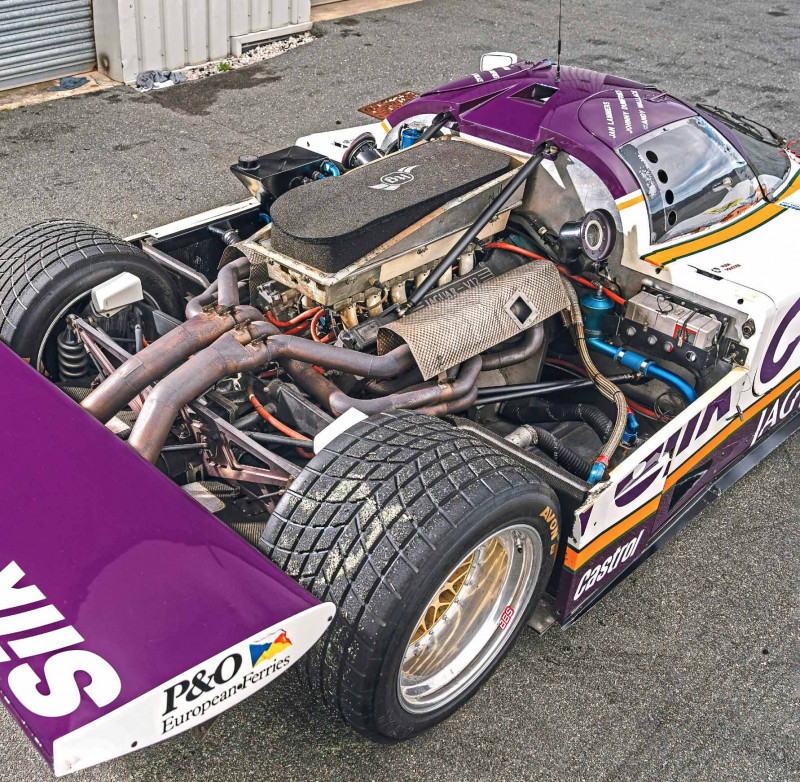
But after a successful return to European and Australian touring-car racing at the hands of Tom Walkinshaw Racing (TWR), and IMSA sports-prototypes with Bob Tullius’ Group 44 squad, Jaguar dived into Group C. Via Sauber, Mercedes-Benz followed suit for the first time since the marque withdrew from racing after the 1955 Le Mans disaster.
It’s important to put mid-Eighties sports car racing in the context of British sport in general back then. Hooliganism and mediocrity had seen the England football team restricted from international competition. No British driver had won the F1 World Championship since James Hunt’s dramatic 1976 triumph. Wimbledon hadn’t seen a British winner in a decade either, and Olympians returned gold medals in single figures. This was the era when Britain’s most high-profile sportsmen wore waistcoats and carried cues.

Against this backdrop, the prospect of Porsche, Jaguar, Mercedes, Aston Martin, Lancia and a host of other historied marques duking it out at Le Mans – with Jaguar as a front-runner – was reminiscent of a misty-eyed era of sports-car racing recalled by a generation of older parents deep in moments of nostalgic reverie. They weren’t long-lost good old days any more, they were happening again, right then in the Eighties. There are few rarer sights than the XJR-9 I’m approaching in Anglesey’s pits. Just nine of these cars were built, specifically for the 1988 World Sports Car Championship. And only one won Le Mans – this one. It’s being carefully wheeled into the pitlane as we arrive, with sunshine breaking through the clouds over Anglesey. Aero covers over the rear wheels. Purple. Silk Cut. Patina, scuffs and light battle scars. Original Le Mans 1988 scrutineering stickers. Goosebumps.
Next to modern road cars milling around by the pitlane, it’s tiny. Wide, yes, but so neat, compact and low. Jock Howe from the Jaguar Daimler Heritage Trust climbs aboard for a warm-up lap. When the XJR-9’s 7.0-litre V12 fires, its vibrations buzz through the tarmac. It’s so resonant, so loud.

Jock gets the Jaguar underway, rolling out of the pitlane and onto the track. He takes things easy as the car comes up to temperature. That enables me to watch the XJR-9 in motion. Like the preceding 1986 XJR-6 and 1987 XJR-8, it was penned by gifted designer Tony Southgate and engineered and run by Tom Walkinshaw Racing. The XJR-6 had marked Jaguar’s arrival in Group C, albeit with mechanical woes, and the XJR-8 won the World Sports Car Championship but missed out on the Le Mans glory that would have crowned a victorious season. Southgate was set an even more daunting task for the 1988 XJR-9 – to design a machine capable of winning both the World Sports Car Championship and IMSA’s parallel GTP series in the US, and have a decent crack at Le Mans too.
The XJR-9 was built around a carbon-kevlar monocoque and, like other challengers from the heady Group C Eighties era, it’s a full ground-effect design with downforce-generating channels within the bodywork to suck the car to the ground, albeit with the venturi tunnels limited to 28cm for 1988 having run wild during Group C’s early years.
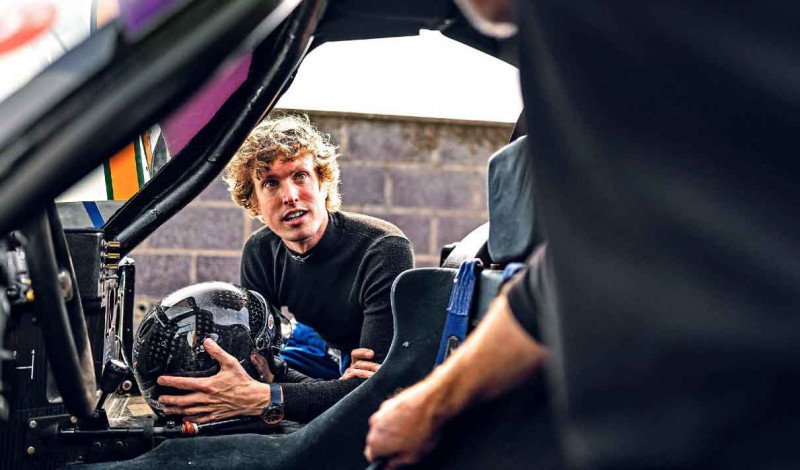
Above the butterfly door, the names of its three drivers from that Le Mans win: Jan Lammers, Andy Wallace and, poignantly, Johnnie Dumfries, who passed away in 2021. Back in the Eighties Wallace was a British Formula 3 champion knocking on the door of Formul 1 but without enough sponsorship funds to get through it. Then Jaguar came calling.
‘I was racing in the Macau F3 Grand Prix at the end of ’86 and had a massive tussle for the lead with Jan Lammers,’ he tells me on the phone in between shifts as Bugatti’s chief test driver. ‘He dropped the car on the brakes coming into the hairpin; most drivers would have spun but he had such fantastic car control he managed to hold onto it. Only thing was, that meant he was pointing directly at the apex barrier… I dived down the inside and in taking the lead, also straightened him up. He was driving for Jaguar, and put in a good word for me… Coming from F3, it was a bit of a shock how big the Jaguar felt in comparison. It’s wickedly fast in a straight line – you set it up for straight-line speed at Le Mans – but don’t forget, it’s a full ground-effect car, so you’ll have an awful lot of downforce to lean on. It’s not usually a very difficult car to drive. Enjoy it.’
Onto Anglesey’s back straight, Jock Howe in the XJR-9 suddenly streaks away before peeling off into the pitlane. It’s ready. Here goes. Fold the driver’s dihedral door upwards and forward and it reveals an enormously broad composite sill to step across. The instruments are analogue, there are three pedals and the steering wheel is big, round and buttonless, but otherwise it feels incredibly modern in here. It even has an electric mirror adjustment switch, albeit from an Austin Montego. Glance in the mirrors and you see Silk Cut script.
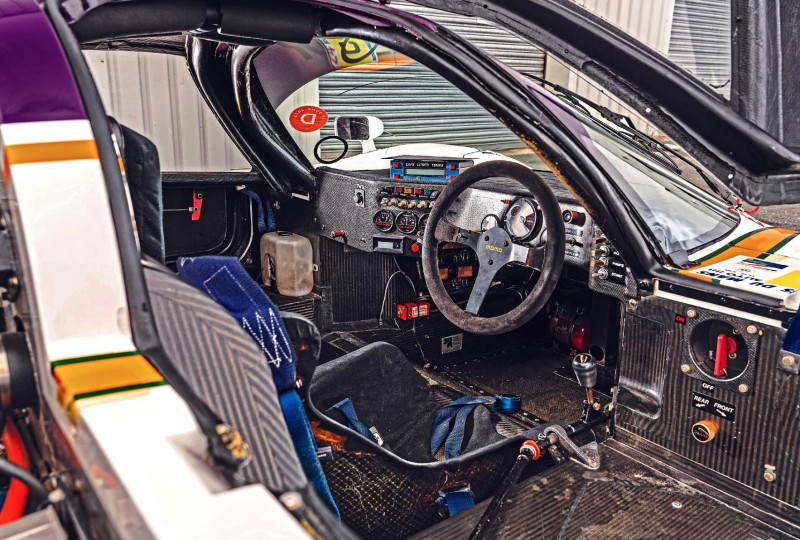
Although the V12 develops peak torque north of 6000rpm, there’s a strict 5000rpm limit today. This is the original engine from Le Mans and by now it’s way past the running hours it was designed for. It’s somewhere well into its second lifespan. ‘It’s in unknown territory,’ Howe smiles. ‘It’s a bit like if your grandfather was a champion 100-metre sprinter in his day, you wouldn’t necessarily ask him to do it now.’
Mind you, smoothly accelerating out of the pitlane, feeling the torque swell and hearing the velvet snarl of the V12 rise, the XJR-9 certainly feels like it’s keen to sprint. It’s just getting into its stride as the tacho needle swings to five, and feels like it could keep pulling forever. Unlike the Porsches the Jaguar battled with in its day, there’s no synchromesh on the H-pattern gearshift, so you need to be accurate with your shifts and be sure to give it a good blip on the way down the ’box.
Fifth gear is very tall. ‘You were only allowed to have five forward gears under Group C regulations,’ Wallace explains, ‘and given that the car had to be able to reach more than 240mph for Le Mans, from fourth to fifth, there’s a big gap.’ I was expecting everything to feel heavy, and true enough there’s no power steering and the brakes need a good firm press.
But with the big steering wheel to balance the effort, it’s not as much of a wrestling match as I’d feared. The most remarkable thing is how modern this 34-year-old car feels. Every response is so instant, and the unseen hand of downforce is ever present. On a bigger, even more open circuit the steering would no doubt get heavier as the downforce builds but you can still feel the ground effect getting to work. We’re on wet tyres; safer than cold slicks, especially because the XJR-9 runs a spool differential to avoid the risk of breaking a driveshaft in an endurance race.
‘We never did break one,’ Wallace recalls. ‘However the downside is you get a lot of understeer in low-speed corners. The trick is to enter a little slower than you would normally, get the car rotated, then you can get on the power.’
The XJR-9 copes fine with Anglesey’s tight Monaco-in-reverse hairpin and the tyres’ tread blocks no doubt help take a little weight out of the steering. With the Jaguar’s aero pushing them into the surface the grip they generate, even on this dry circuit, is enormous. When I pit, they’re ruined; the tyre surfaces look like they’ve been torched and then used as a Dobermann’s chew toy.
I’m buzzing with adrenaline, and very, very hot. It’s toasty in the cockpit. The rear bodywork is removed to let the car cool down too, and it suddenly becomes apparent just how much engine there is behind you. It’s enormous. And with humble origins: it’s a two-valve V12, closely related to the XJ-S production car’s lump, which itself had its roots in a design from the Fifties. And that engine was partly envisaged as a racing successor to the straight-six D-type Le Mans racer. It did the job, just a little further down the line than expected.
TWR also experimented with a 48-valve version of the V12, but it proved unreliable. TWR’s racing engine manager, New Zealander Allan Scott, initially looked to lighten it, before becoming concerned that doing so would compromise its role as a stressed chassis member. Eventually he opted for a combination of sheer displacement and simplicity, retaining a single overhead camshaft per bank and increasing the displacement first to 6.3, then 7.0 litres for Le Mans – IMSA regulations limited it to 6.0 litres in other races. Fuel consumption naturally suffered – a big problem given Group C’s fuel-allowance formula – something TWR attempted to mitigate using Jaguar’s latest Zytek engine-management computers. These took a while to get to work, however – Jaguar lost the 1986 World Championship because of regular misfires and apparent fuel starvation caused by overly zealous computerised metering. Jaguar’s 1987 switch from three smaller fuel tanks to one large one helped simplify the system, add reliability and deliver the title, but not the Le Mans crown. A year later, however, this car did.
Last year I drove the 1987 Porsche 962 Group C car: a Shell Dunlop-liveried example just like the ones Jaguar battled in that fairytale it’s-coming-home 1988 win. The Jaguar feels the more modern car. It was designed later; it has a composite monocoque compared with an aluminium one that overcame Porsche engineer Norbert Singer’s concerns regarding the fragility of carbonfibre by blending it with Kevlar thanks to the work of Advanced Composite Technologies in Derby. It feels less claustrophobic inside than the Porsche, its driving position more central. But its gearchange is less friendly – you need to be on your game – and the two engines have a totally different character. The 962’s fabulously gruff flat-six is all boost: progressive turbo lag giving way to a tidal wave of acceleration. The Jag’s naturally aspirated big V12 is more tractable, more linear in its power delivery. Both are unforgettable peaks of sports car racing’s history, yet their respective approaches to victory couldn’t be more different.
Jaguar won Le Mans again in 1990, with the XJR-12. In many ways it was Jaguar’s last great international victory. Formula 1 didn’t work out in the 2000s; it’s achieving great things in Formula E but… it’s not Le Mans, is it? As Jaguar seeks to reinvent itself for an uncertain future, let’s hope a little of the magic of the Silk Cut XJRs and the groundswell of public support they inspired is still there in the West Midlands water. A little of the fire and brimstone of the 1988 race is in Jaguar somewhere: hopefully there are still more sporting fairytales to be written in future decades.
TECHNICAL DATA 1988 Jaguar XJR-9LM
- Engine 6995cc V12, sohc per bank, Zytek electronic fuel injection
- Max Power 750bhp @ 7200rpm
- Max Torque 611lb ft @ 5500rpm
- Transmission Five-speed manual, rear-wheel drive
- Steering Rack and pinion
- Suspension Front: double wishbones, horizontal pushrods, coil springs, telescopic dampers. Rear: magnesium alloy MacPherson struts, coil
- springs, telescopic dampers
- Brakes Discs front and rear
- Weight 900kg
- Performance Top speed: 245mph
- Acceleration 0-60mph 2.4sec
- Fuel consumption 8mpg
Will we see a car like this from Jaguar again? Jaguar’s Le Mans V12 ambitions began in the 1950s
TOM WALKINSHAW: JAGUAR’S MASTERMIND
Having been established to run touring-car programmes for Mazda, then Rover, in the British Saloon Car Championship, Tom Walkinshaw Racing (TWR) was ideally placed to approach Jaguar with the offer of a racing programme for 1981. The timing was perfect: John Egan had been appointed to lead Jaguar out of British Leyland and into privatisation, and the FIA had announced a new simplified formula for touring, GT and prototype competition with Groups A, B and C. Walkinshaw’s brief involvement with Alpina had convinced him the XJ-S could defeat BMW in the European Touring Car Championship, and he successfully approached Egan with the offer of a privateer XJ-S programme for 1982. By 1984, Motul sponsorship had given way to official Jaguar backing – the year Walkinshaw secured the drivers’ championship in the XJ-S. But Jaguar wanted manufacturers’ titles, and the ETCC’s class structure meant Alfa Romeo and Volkswagen repeatedly triumphed. By this point TWR’s experience with the V12 meant TWR was perfectly placed to create a car for an arena Jaguar could dominate – Group C.
‘When I pit, the tyre surfaces look like they’ve been torched’
Downforce felt physically at high speed Cabin has surprise Montego bits Ground effect venturis were limited for ’88. Jaguar power, but XJR-9 was TWR creation. XJR-9 not heavy, but understeers into corners. Getting to grips with Gp C needs special tuition. Low-drag shape gave 240mph+ potential on the Mulsanne. Composite monocoque more advanced than Porsche’s ‘There are few rarer sights than the XJR-9 I’m approaching...’ 1988 XJR-9 was icon of sporting pride, for Jaguar and Britain


